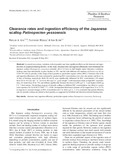Clearance rates and ingestion efficiency of the Japanese scallop Patinopecten yessoensis
Share
စိတ္တဇ
In coastal ecosystems, variations in food quantity may have significant effects on the clearance and ingestion rates of suspension-feeding bivalves. In this study, clearance rates and ingestion efficiencies were determined for Japanese scallop (Patinopecten yessoensis) juveniles (60.6±4.5 mm in shell height) under laboratory conditions. Scallops were kept individually in glass beakers at 15°C and fed with different cell numbers of Pavlova sp. (0.8 to 57.60×106 cells) to provide a wide range of food quantity as particulate organic carbon (POC). Clearance rates (CR) and ingestion efficiencies (IE) were estimated by monitoring POC concentration over a two-day period, and from 2 to 14 days of feeding, respectively. Both CR and IE were significantly influenced by POC concentration. CR ranged from 15.8 to 38.5 mL ind-1 h-1 (or 8.9 to 49.6 mg Ch-1 g dry weight-1) with maximum values at high POC concentrations. IE varied from 40 to 71% and differed significantly between the lowest (2,900 μg C L-1) and highest (8,000 μg C L-1) food rations. The feeding response of juvenile scallops to different POC concentrations was fitted to a power curve equation: \(\mathsf{IE}\,(\%)=0.9272 \times \mathsf{POC}^{0.5105}, r=0.98\). Extrapolated field-based estimates of IE ranged from 7.8 to 12.7% in response to seasonal changes in POC concentration (64.5 to 168.6 μg C L-1). It is concluded that particle filtration rates by juvenile scallops are related to food quantity, as suggested by both field and laboratory-derived feeding rates.
Suggested Citation
Aya, F., Hidaka, Y., & Kudo, I. (2013). Clearance rates and ingestion efficiency of the Japanese scallop Patinopecten yessoensis. Plankton and Benthos Research , 8(3), 134-140. https://doi.org/10.3800/pbr.8.134
ဘာသာရပ်
Taxonomic term
စုစည်းမှုများ စုစည်းမှုများ
- AQD Journal Articles [1222]



